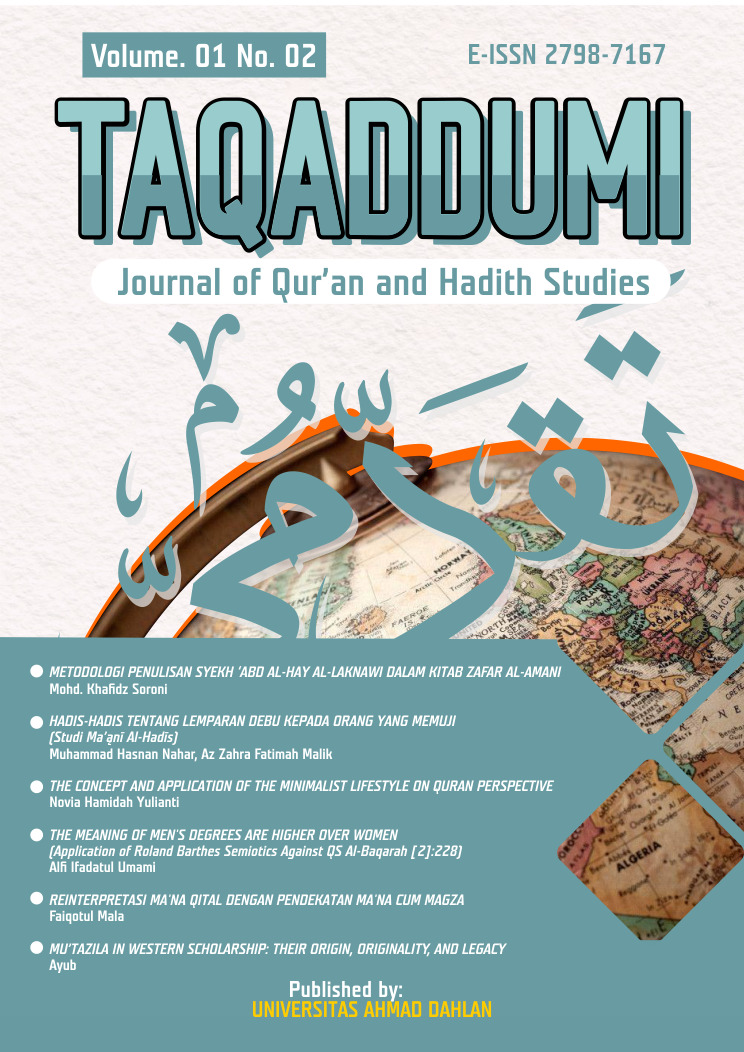THE MEANING OF MEN'S DEGREES ARE HIGHER OVER WOMEN (Application of Roland Barthes Semiotics Against QS Al-Baqarah [2]:228)
DOI:
https://doi.org/10.12928/taqaddumi.v1i2.4822Keywords:
Darajah, Linguistic System, Roland Barthes, Semiotics, The Mythological SystemAbstract
This paper discusses the meaning of the word darajah in The Qur'an in particular in QS al-Baqarah [2]:228 which seems to be used as legitimacy for gender-biased people who think that women are left behind. In the study of semiotics, the word darajah is a symbol in the delivery of messages that must be interpreted. One of the relevant semiotic theories to be used in this paper is Roland Barthes' semiotics. In general, the semiotics offered by Barthes have two stages. The first stage is called the linguistic system and the second stage is called the mythological system. Next, the author will apply Barthes' semiotic theory to understand the meaning of the word darajah in QS al-Baqarah [2]: 228. The result is namely, the linguistic system in the word darajah is defined as position, leadership, and the rank of men is higher than women. While the mythological system is the meaning of the word darajah in this verse, namely the husbands have more right to take the wife back if he wants reconciliation with good intentions. The ideology or message contained in the verse is the relationship between husband and wife who have equal rights and obligations in the household.
References
Al-Ashfahani, Al-Raghib. Kamus Al-Qur’an Jilid 3. Translated by Ahmad Zaini Dahlan. Vol. 3. Depok: Pustaka Khazanah Fawa’id, 2017.
al-Azhari. “Tahzib Al-Lughah, al-Maktabah al-Syamilah.†Accessed May 23, 2021. http://www.alwarraq.com/.
Al-Jauziyyah, Ibn Qayyim. Zadul Ma’ad: Jalan Menuju Ke Akhirat. Translated by Kathur Suhardi. Jakarta: Gema Insani, 2011.
Al-Jazairi, Abu Bakar Jabir. Minhajul muslim: pedoman hidup harian seorang muslim. Translated by Taufiq Aulia Rahman and Ikhwanuddin Abdullah. Ummul Qura, 2019.
Al-Qurthubi. “تÙسير القرطبي | 2:228 | الباØØ« القرآني.†Accessed May 23, 2021. https://tafsir.app/qurtubi/2/228.
Al-Thabari. “تÙسير الطبري | 2:228 | الباØØ« القرآني.†Accessed May 23, 2021. https://tafsir.app/tabari/2/228.
Amin, Muhammad. “Konsep €˜darajahâ€TM: Solusi Al-Quran Dalam Mengatasi Beban Ganda Wanita Karier.†Jurnal Bimas Islam 9, no. 2 (June 30, 2016): 323–70.
Ardiansyah. “Semiotika Warna Hijau Dalam Al-Quran (Analisis Semiotika Roland Barthes).†Insyirah: Jurnal Ilmu Bahasa Arab Dan Studi Islam 3, no. 1 (June 10, 2020): 41–52.
Asriningsari, Ambarini, and Nazla Umaya. Semiotika Teori Dan Aplikasi Pada Karya Sastra. Semarang: UPGRIS PRESS, 2018.
As-Suyuthi, Jalaluddin. Asbabun Nuzul; Sebab Turunnya Ayat Al-Quran. Translated by Abdul Hayyie al-Kattani. Gema Insani, 2008.
Az-Zuhaili, Wahbah. Tafsir Al-Munir : Aqidah, Syariah, Manhaj. Translated by Abdul Hayyie al-Kattani. Vol. Jilid 5. Jakarta: Gema Insani, 2018.
Baedhowi. Antropologi Al-Quran. Yogyakarta: LKIS, 2009.
Barthes, Roland. Elemen-Elemen Semiologi. Translated by Kahfie Nazaruddin. Yogyakarta: Jalasutra, 2012.
Cobley, Paul, and Litza Jansz, eds. Introducing Semiotics. Thriplow: Icon Books [u.a.], 2005.
Departemen Agama RI. Al-Qurʼan dan tafsirnya. Ed. yang disempurnakan. Vol. 1. Jakarta: Lentera Abadi, 2004.
Fatah, Abdul. “Analisis Semiotika Roland Barthes Tentang Ashabul Fil.†AL-TADABBUR 5, no. 2 (February 20, 2020): 233–48.
Hamka. Tafsir Al-Azhar. Vol. 1. Jakarta: Pustaka Pelajar, 2015.
Hidayat, Komarudin. Memahami Bahasa Agama : Sebuah Kajian Hermeneutik. Cet. 1. Paramadina, 1996.
Hidayat, Wildan. “Representasi Makna Ideologis Kisah Aṣḥâb Al-Kahf: Analisis Semiotika Roland Barthes Dalam Surah Al-Kahf.†Mutawatir 8, no. 1 (July 20, 2020): 170–90. https://doi.org/10.15642/mutawatir.2018.8.1.170-190.
Ibnu Katsir. “تÙسير ابن كثير | 2:228 | الباØØ« القرآني.†Accessed May 23, 2021. https://tafsir.app/ibn-katheer/2/228.
Iman, Fuji Nur. “Mitologi Naskh Intra Quranic (Studi Atas Q.S. Al-Baqarah Ayat 106 Aplikasi Teori Semiologi Roland Barthes).†Nun : Jurnal Studi Alquran Dan Tafsir Di Nusantara 4, no. 2 (September 9, 2019): 27. https://doi.org/10.32495/nun.v4i2.66.
Imron, Ali. Semiotika Al-Qur’an; Metode Dan Aplikasi Terhadap Kisah Yusuf. Yogyakarta: Teras, 2015.
Khikmatiar, Azkiya. “Konsep Poligami Dalam Al-Qur’an (Aplikasi Semiologi Roland Barthes).†QOF 3, no. 1 (June 15, 2019): 54–66. https://doi.org/10.30762/qof.v3i1.903.
Khoyin, Muhammad. Filsafat Bahasa. Bandung: Pustaka Setia, 2013.
Mukhtar, Naqiyah. “Reinterpretasi Derajat Laki-Laki Lebih Tinggi Atas Perempuan Dalam Surat Al-Baqarah/2: 228.†Yinyang: Jurnal Studi Islam Gender dan Anak 4, no. 2 (2009): 249–60.
Munawwir, Ahmad Warson. Al-Munawwir: kamus Arab-Indonesia. Surabaya: Pustaka Progresif, 1997.
Nuroniyah, Wardah. “Diskursus ‘Iddah Berpersepktif Gender: Membaca Ulang ‘Iddah Dengan Metode DalÄlah al-Naṣṣ.†Al-Manahij: Jurnal Kajian Hukum Islam 12, no. 2 (December 5, 2018): 193–216. https://doi.org/10.24090/mnh.v12i2.1745.
Pawito. Penelitian komunikasi kualitatif. Yogyakarta: Lembaga Kajian Islam dan Sosial (LKIS), 2007.
Ratna, Nyoman Kutha. Teori, metode, dan teknik penelitian sastra. Yogyakarta: Pustaka Pelajar, 2008.
Rusmana, Dadan. Filsafat Semiotika: Paradigma, Teori, Dan Metode Interpretasi Tanda Dari Semiotika Struktural Hingga Dekonstruksi Praktis. Bandung: Pustaka Setia, 2014.
Saeed, Abdullah. Interpreting the QurʼÄn: Towards a Contemporary Approach. New York: Routledge, 2006.
Saheeh International. “The Noble Quran, Surah Al-Baqarah.†Accessed May 23, 2021. https://quran.com/al-baqarah?locale=en&font=v1&reading=false&translations=20.
———. “The Noble Quran, Surah An-Nisa.†Accessed May 23, 2021. https://quran.com/an-nisa?locale=en&font=v1&reading=false&translations=131%2C20.
Sastradinata, Dhevi Nayasari. “Pelaksanaan Ruju’ Pada Kantor Urusan Agama Kecamatan Lamongan.†Jurnal Independent 2, no. 1 (June 1, 2014): 76. https://doi.org/10.30736/ji.v2i1.20.
Saussure, Ferdinand de. Pengantar linguistik umum. Translated by Rahayu S . Hidayat. Bulaksumur, Yogyakarta: Gadjah Mada Univ. Press, 1988.
Shihab, M. Quraish. Tafsîr Al-Mishbâẖ : Pesan, Kesan, dan Keserasian al-Qurʾan. Vol. 5. Jakarta: Lentera Hati, 2012.
Shihab, Moh Quraish. Wawasan Al-Quran: Tafsir Maudhu’i Atas Pelbagai Persoalan Umat. Bandung: Mizan, 1996.
Sobur, Alex, and Yasraf Amir Piliang. Semiotika komunikasi. Bandung: Remaja Rosdakarya, 2006.
ULUFATUL KHOIRIYAH, NIM 10530069. “Perempuan Sebagai Harsun Dalam Al-Qur’an (Kajian Semiotika Roland Barthes).†Skripsi, UNIVERSITAS ISLAM NEGERI SUNAN KALIJAGA, 2014. https://digilib.uin-suka.ac.id/id/eprint/13869/.
Umaroh, Dewi. “Makna ’Abasa Nabi Muhammad Dalam Al-Qur’an (Aplikasi Semiotika Roland Barthes Terhadap QS.’Abasa [80]: 1).†Al-Bayan: Jurnal Studi Ilmu Al- Qur’an dan Tafsir 5, no. 2 (December 31, 2020). https://doi.org/10.15575/al-bayan.v5i2.11640.
Wibowo, Indiwan Seto Wahyu. Semiotika Komunikasi : Aplikasi Praktis bagi Penelitian dan Skripsi Komunikasi. Mitra Wacana Media, 2013.
Zoest, Aart Van. Serba-Serbi Semiotika. Jakarta: Gramedia Pustaka Utama, 1991.
Downloads
Published
Issue
Section
License
Copyright (c) 2022 Alfi Ifadatul Umami

This work is licensed under a Creative Commons Attribution-ShareAlike 4.0 International License.
License and Copyright Agreement
In submitting the manuscript to the journal, the authors certify that:
- They are authorized by their co-authors to enter into these arrangements.
- The work described has not been formally published before, except in the form of an abstract or as part of a published lecture, review, thesis, or overlay journal. Please also carefully read the Taqaddumi Author Guidelines at http://journal2.uad.ac.id/index.php/taqaddumi/about/submissions#onlineSubmissions
- That it is not under consideration for publication elsewhere,
- That its publication has been approved by all the author(s) and by the responsible authorities – tacitly or explicitly – of the institutes where the work has been carried out.
- They secure the right to reproduce any material that has already been published or copyrighted elsewhere.
- They agree to the following license and copyright agreement.
Copyright
Authors who publish with the Taqaddumi Journal agree to the following terms:
- Authors retain copyright and grant the journal right of first publication with the work simultaneously licensed under a Creative Commons Attribution License (CC BY-SA 4.0) that allows others to share the work with an acknowledgment of the work's authorship and initial publication in this journal.
- Authors are able to enter into separate, additional contractual arrangements for the non-exclusive distribution of the journal's published version of the work (e.g., post it to an institutional repository or publish it in a book), with an acknowledgment of its initial publication in this journal.
- Authors are permitted and encouraged to post their work online (e.g., in institutional repositories or on their website) prior to and during the submission process, as it can lead to productive exchanges, as well as earlier and greater citation of published work.









